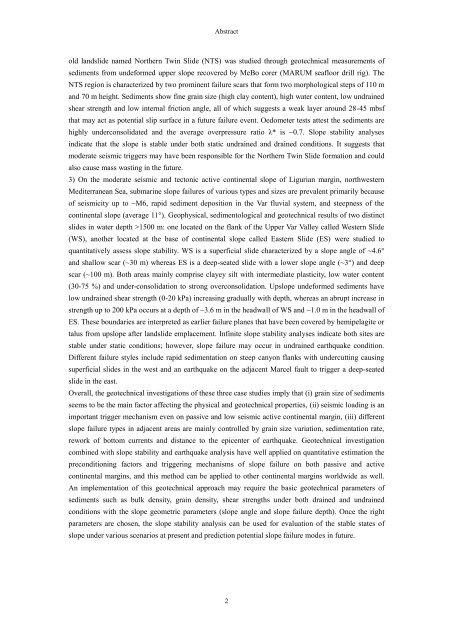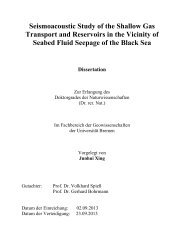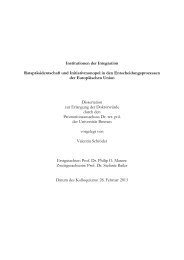Slope stability along active and passive continental margins ... - E-LIB
Slope stability along active and passive continental margins ... - E-LIB
Slope stability along active and passive continental margins ... - E-LIB
You also want an ePaper? Increase the reach of your titles
YUMPU automatically turns print PDFs into web optimized ePapers that Google loves.
Abstract<br />
old l<strong>and</strong>slide named Northern Twin Slide (NTS) was studied through geotechnical measurements of<br />
sediments from undeformed upper slope recovered by MeBo corer (MARUM seafloor drill rig). The<br />
NTS region is characterized by two prominent failure scars that form two morphological steps of 110 m<br />
<strong>and</strong> 70 m height. Sediments show fine grain size (high clay content), high water content, low undrained<br />
shear strength <strong>and</strong> low internal friction angle, all of which suggests a weak layer around 28-45 mbsf<br />
that may act as potential slip surface in a future failure event. Oedometer tests attest the sediments are<br />
highly underconsolidated <strong>and</strong> the average overpressure ratio λ* is ~0.7. <strong>Slope</strong> <strong>stability</strong> analyses<br />
indicate that the slope is stable under both static undrained <strong>and</strong> drained conditions. It suggests that<br />
moderate seismic triggers may have been responsible for the Northern Twin Slide formation <strong>and</strong> could<br />
also cause mass wasting in the future.<br />
3) On the moderate seismic <strong>and</strong> tectonic <strong>active</strong> <strong>continental</strong> slope of Ligurian margin, northwestern<br />
Mediterranean Sea, submarine slope failures of various types <strong>and</strong> sizes are prevalent primarily because<br />
of seismicity up to ~M6, rapid sediment deposition in the Var fluvial system, <strong>and</strong> steepness of the<br />
<strong>continental</strong> slope (average 11°). Geophysical, sedimentological <strong>and</strong> geotechnical results of two distinct<br />
slides in water depth >1500 m: one located on the flank of the Upper Var Valley called Western Slide<br />
(WS), another located at the base of <strong>continental</strong> slope called Eastern Slide (ES) were studied to<br />
quantitatively assess slope <strong>stability</strong>. WS is a superficial slide characterized by a slope angle of ~4.6°<br />
<strong>and</strong> shallow scar (~30 m) whereas ES is a deep-seated slide with a lower slope angle (~3°) <strong>and</strong> deep<br />
scar (~100 m). Both areas mainly comprise clayey silt with intermediate plasticity, low water content<br />
(30-75 %) <strong>and</strong> under-consolidation to strong overconsolidation. Upslope undeformed sediments have<br />
low undrained shear strength (0-20 kPa) increasing gradually with depth, whereas an abrupt increase in<br />
strength up to 200 kPa occurs at a depth of ~3.6 m in the headwall of WS <strong>and</strong> ~1.0 m in the headwall of<br />
ES. These boundaries are interpreted as earlier failure planes that have been covered by hemipelagite or<br />
talus from upslope after l<strong>and</strong>slide emplacement. Infinite slope <strong>stability</strong> analyses indicate both sites are<br />
stable under static conditions; however, slope failure may occur in undrained earthquake condition.<br />
Different failure styles include rapid sedimentation on steep canyon flanks with undercutting causing<br />
superficial slides in the west <strong>and</strong> an earthquake on the adjacent Marcel fault to trigger a deep-seated<br />
slide in the east.<br />
Overall, the geotechnical investigations of these three case studies imply that (i) grain size of sediments<br />
seems to be the main factor affecting the physical <strong>and</strong> geotechnical properties, (ii) seismic loading is an<br />
important trigger mechanism even on <strong>passive</strong> <strong>and</strong> low seismic <strong>active</strong> <strong>continental</strong> margin, (iii) different<br />
slope failure types in adjacent areas are mainly controlled by grain size variation, sedimentation rate,<br />
rework of bottom currents <strong>and</strong> distance to the epicenter of earthquake. Geotechnical investigation<br />
combined with slope <strong>stability</strong> <strong>and</strong> earthquake analysis have well applied on quantitative estimation the<br />
preconditioning factors <strong>and</strong> triggering mechanisms of slope failure on both <strong>passive</strong> <strong>and</strong> <strong>active</strong><br />
<strong>continental</strong> <strong>margins</strong>, <strong>and</strong> this method can be applied to other <strong>continental</strong> <strong>margins</strong> worldwide as well.<br />
An implementation of this geotechnical approach may require the basic geotechnical parameters of<br />
sediments such as bulk density, grain density, shear strengths under both drained <strong>and</strong> undrained<br />
conditions with the slope geometric parameters (slope angle <strong>and</strong> slope failure depth). Once the right<br />
parameters are chosen, the slope <strong>stability</strong> analysis can be used for evaluation of the stable states of<br />
slope under various scenarios at present <strong>and</strong> prediction potential slope failure modes in future.<br />
2
















